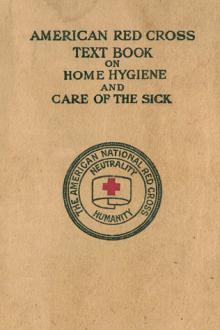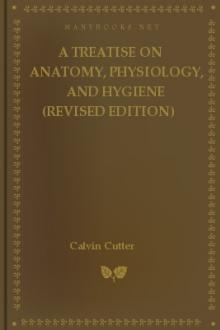American Red Cross Text-Book on Home Hygiene and Care of the Sick by Isabel McIsaac (best affordable ebook reader txt) 📕

- Author: Isabel McIsaac
- Performer: -
Book online «American Red Cross Text-Book on Home Hygiene and Care of the Sick by Isabel McIsaac (best affordable ebook reader txt) 📕». Author Isabel McIsaac
On the other hand, a person who is responsible for the care of a patient must be made to realize that she and she only is ultimately responsible during the entire 24 hours of every day. Being responsible for a patient does not mean that she should be with him every minute, or do everything herself: it does mean that she should plan so effectively that everything necessary is done, either by herself or by another competent person. When she goes away for even half an hour, she should appoint someone else to be responsible in her place and to her when she comes back. She must consequently make very clear just what she wants done. If there is medicine, nourishment, or treatment to be given, she can easily make a list, with the time for each, and ask that each item be crossed off the list as soon as the work has been done. She should not forget to ask for the list when she returns.
What is really needed is a little executive ability. As Florence Nightingale said:
"It is impossible in a book to teach a person in charge of the sick how to manage, as it is to teach her how to nurse. Circumstances must vary with each different case. But it is possible to press upon her to think for herself. Now what does happen during my absence? I am obliged to be away on Tuesday. But fresh air, or punctuality is not less important to my patient on Tuesday than it was on Monday. Or: At 10 p.m. I am never with my patient; but quiet is of no less consequence to him at 10 than it was at 5 minutes to 10. Curious as it may seem, this very obvious consideration occurs comparatively to few, or, if it does occur, it is only to cause the devoted friend or nurse to be absent fewer hours, or even fewer minutes from her patient—not to arrange so as that no minute and no hour shall be for her patient without the essentials of her nursing."—(Notes on Nursing.)
It is exceedingly difficult to care for members of one's own family or to be cared for by them. Too much or too little is almost invariably expected by one person or the other, and where great affection is involved not only is the strain increased on both sides, but often harm results from too great unselfishness on either side or both. But sometimes the reverse is true, and then one should remember that normal behavior may be impossible for the sick. During weakness and pain, irritability and unreasonableness are as characteristic as other symptoms, and it is as foolish to demand a normal mental state from a sick person as it would be to demand a normal temperature. For a cheerful, reasonable, and unselfish patient—and there are surprisingly many—one should be devoutly thankful, but patience and pity should be given no less to those whose tortured nerves cause suffering to others as well as to themselves.
Every woman who cares for the sick should remember that she is the patient's chief if not his only link with the normal world, and that his plight is pitiful indeed if she is complaining or irritable or unwilling. Anyone who cares for the sick should remember also that she is necessarily in a most intimate relation with the patient, and that such enforced intimacy calls for extra consideration on her part, and for the most scrupulous respect for confidential matters. It is inexcusable even for members of the patient's family to discuss with one another the patient's private concerns, or his queer or unreasonable or annoying ways. During sickness the skeletons in most people's mental closets walk forth, and anyone who misuses special opportunities to know intimate affairs can only be classed with eavesdroppers and village gossips.
EXERCISES What are the essentials of a good sick room as to: (a) Situation and exposure. (b) Lighting and heating. (c) Furnishing. (d) Ventilation. How may a sick room be ventilated without exposing the patient to draughts? How should the bed be placed in relation to doors, windows, and walls? How should a sick room be cleaned? What in general are the duties of the attendant? Make a plan of your own bedroom, and show what changes, if any, would be desirable if it were to be used as a sick room. FOR FURTHER READING Notes on Nursing—Florence Nightingale, Pages 1-63, 84-105. CHAPTER VIBEDS AND BEDMAKING
The common saying that the best bed for an invalid is his own bed contains an element of truth. Taking from a patient his own accustomed bed, even when a better is substituted, sometimes disturbs him greatly and makes him feel that he is indeed very ill. Nevertheless, a suitable bed is essential to the proper care of a helpless person, and no patient should continue to use an unsuitable one, unless his illness is slight and also likely to be of very short duration.
Besides being comfortable, a bed suitable for the sick must be clean and easy to keep in a sanitary condition. The springs should be firm, and the mattress should be elastic and should give an even support without lumps and hollows. The bed covers should be clean, light, and warm; the pillows should be sufficient in number not only to make the head and shoulders comfortable, but also any other part of the body in need of support. Moreover, the bed should be so placed and of such a kind that the work of caring for the patient may be rendered as easy for the attendant as possible. In every household at least one bed suitable for a sick person should be available in case of need.
—Beds of white enameled iron, brass, or brass and iron combined are most easily kept clean, and are the best in every way. The frame should be strong enough to stand firmly, yet not so heavy that it is hard to move. It should have as few angles as possible, and all its joints should be smooth and well finished. The springs should be made of wire stretched tightly on a metal frame that fits smoothly into the head and foot pieces. Large castors should be used; they may be removed from the foot if the bed moves too easily.
A bed to be used in sickness should have the following dimensions—length, 6 ft. 6 in., height 24 to 26 inches, width, 36 inches. If a bed is either too high or too low the labor of lifting and moving the patient is greatly increased. If the bed is too narrow the patient is insecure. If the bed is too wide, its center is difficult or impossible to reach without leaning or kneeling upon it; and if too short, it will prove uncomfortable for a tall person. A bed that is too low may be raised on four heavy boxes of the same height; or still better, upon heavy wooden blocks which any carpenter can easily make, and which are well worth a little trouble to obtain. In the top of each block a hollow should be made into which the leg of the bed will fit after the castor has been removed. A broad firm stool or a low chair may be provided for a patient who has difficulty in getting in and out of a high bed.
Beds with complicated attachments for moving patients are not recommended for family use. They are expensive, likely to get out of order, seldom needed, and generally unsatisfactory. In some surgical cases a bed with a firm, flat surface is necessary. Such a surface may be secured by placing between the mattress and springs two boards slightly separated, or one wide board with holes bored in it to afford ventilation.
Wooden beds are undesirable: they are difficult to keep clean, they readily absorb moisture and odors, they cannot well be disinfected, and their solid frames prevent a free circulation of air. Moreover, it is almost impossible to render fit for use again a wooden bed into which vermin have once made their way. Folding beds and lounges even of the best type are unhygienic, usually too low for the patient's comfort, and often insecure.
A bedstead should be wiped frequently with a damp cloth; if it is of enameled iron it may be washed with soap and water. The springs may be cleansed with a stiff brush dipped in kerosene oil. Excessive use of water upon the springs is likely to make them rust.
—Various substances are used in the manufacture of mattresses, but nothing has yet been found that is as satisfactory as curled hair. It is light and clean and elastic, it does not readily absorb odors, and it is easily renovated. Although hair is more costly than other materials, a hair mattress may be used almost indefinitely if it is occasionally made over.
Felt or cotton mattresses are firm, but heavy, difficult to keep clean, and likely to absorb odors. A useful mattress made from straw is sometimes found in country districts. Such a bed is thoroughly hygienic, for the worn straw may be burned and the tick washed and refilled with clean straw; but straw beds are generally hard and lumpy. The least desirable of all mattresses is the old fashioned feather bed, and it should never be used if a better can by any possibility be obtained; but a feather bed should not be arbitrarily taken away from an old person accustomed to its use, unless his welfare is really at stake.
A mattress made in two sections is unnecessary for a single bed; indeed, a mattress made in one piece is more easily kept in place if the patient is restless. A good quality of blue and white ticking makes a serviceable cover for both mattress and pillows since its color is not likely to run.
—A mattress should be brushed frequently with a whisk broom, especially around the tufts and edges. If a patient is long confined to bed, a fresh one should occasionally be substituted so that the regular mattress may be removed, well brushed, beaten with a carpet beater, and left exposed to the sun and air for a day or two. A mattress that is badly soiled should be sent to a cleaner and made over; it cannot be cleaned properly at home. It is generally possible to remove blood stains, if they have not soaked through the ticking, by applying a thick cream made from raw starch and cold water. When the starch becomes dry it should be brushed away, and the application should be repeated until the stain has disappeared. For the best results the starch should be applied before the stain is dry.
—One patient can use an almost unlimited number of feather pillows. Some should be soft and others firm, some large and some small; but pillows that are very large and thick are less useful than a greater number of smaller ones. It is well to have several small pillows of varying size and thickness to support different parts of the body.
Hair pillows are often acceptable in warm weather, and they are also desirable for patients with high fever or excessive perspiration. Rubber air pillows are a convenience in traveling and





Comments (0)